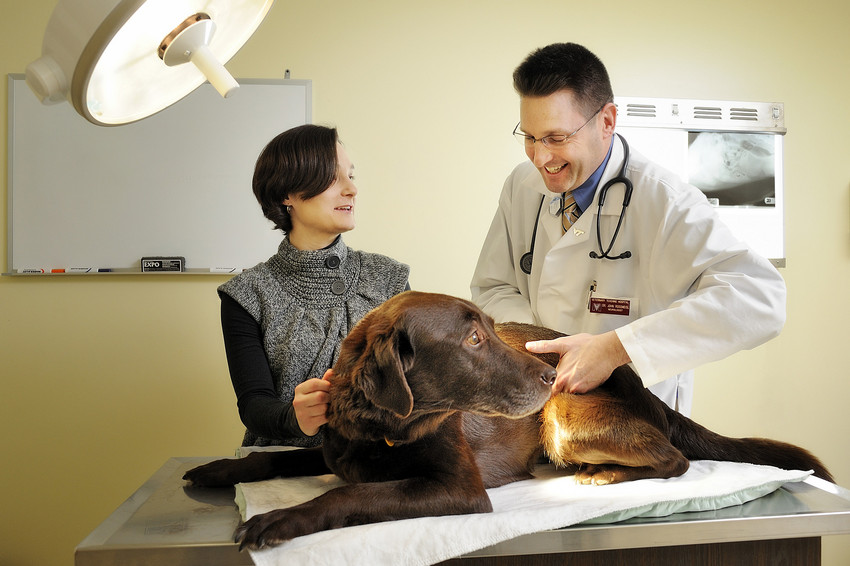Translational medicine turns Virginia Tech's innovations in the life sciences into clinical solutions

Faculty members in several Virginia Tech colleges have been tearing down academic boundaries and speeding up the rate that basic molecular research turns into practical biomedical advances, all in the name of “translational medicine.”
Dr. John Rossmeisl, associate professor of small animal clinical sciences in the Virginia-Maryland Regional College of Veterinary Medicine, is one of these faculty members. He has partnered with Wake Forest University to develop improved therapeutic approaches for managing gliomas. These serious forms of brain tumors gained notoriety following the death of Sen. Edward “Ted” Kennedy in 2009 and are the second leading cause of cancer deaths for men under 40 and for women under 20.
“We are developing technology that destroys these types of brain tumors and opens up the blood-brain barrier so that we can get life-saving drugs to the brain in both dogs and humans,” said Rossmeisl, who explained that both species demonstrate similar clinical signs and pathobiology but that the tumors occur three times more often in dogs than in people.
Like other translational medicine projects, this research focuses on turning the biological discoveries of scientists and clinical researchers into clinical solutions for patients, whether humans or animals. Faculty members in the College of Agriculture and Life Sciences and the College of Science are also working in the field of translational medicine.
Virginia Tech is developing plans for a Translational Medicine Building, which will include an expansion of the Veterinary Teaching Hospital as well as research laboratories and training spaces for interdisciplinary research among these three colleges. The feasibility study should be complete in May of 2012.
Rossmeisl and his colleagues have identified two novel receptors that are present only in cancer cells and not normal brain cells. “These receptors offer unique targets for delivery in molecular toxins to the brain cancer cells to kill them without harming the normal brain,” he added.
He is working with Rafael Davalos, associate professor of biomedical engineering in the College of Engineering, on electroporation – or the use of electrical fields to increase the permeability of cell membranes to deliver medication past the blood-brain barrier.
Rossmeisl is also investigating improved approaches for delivering radiation therapy for other forms of brain cancer in dogs. Although the veterinary standard calls for fractional radiotherapy delivered with a linear accelerator, Rossmeisl hopes to perfect the use of stereotactic radiosurgery, also known as the “gamma knife.” The gamma knife technology delivers a beam of cancer-killing radiation with pinpoint accuracy and only takes one session over a few hours, as opposed to multiple sessions over several weeks.
David Gerrard, professor and head of the Department of Animal and Poultry Sciences in the College of Agriculture and Life Sciences, and his colleagues Jeffery Escobar, assistant professor of animal and poultry sciences, and Jason Scheffler, research assistant professor, are leading a translational project that has found a possible animal model to study childhood obesity.
“In a 16-week study, we fed pigs for the first six to eight weeks on a high-fat and high-sugar diet and then tested their ability to clear glucose from their blood,” Gerrard said. “We found that pigs on this high-energy diet had difficulty processing the glucose. In other words, when students gave these pigs an insulin challenge, they presented signs hallmark of diabetes at a very early age, synonymous with childhood age in humans.”
According to Gerrard, the project provides a model to study childhood obesity. This topic has received significant attention in recent years because of increasing prevalence of and obesity in children across the globe. “Unfortunately, traditional rodent-based models fall short as a useful model for studying this malady. Pigs, on the other hand, easily translate into this and other human health applications,” he said.
Carla Finkielstein, associate professor of biological sciences in the College of Science, has focused her research on how changes in circadian rhythms and the cell cycle may contribute to the development of breast cancer in women. This translational research aims to help medical professionals treat tumors more effectively by searching for clues about the best time to administer medication.
“A fundamental feature of all living organisms is the presence of two, 24-hour oscillating cyclic systems,” Finkielstein said. “My laboratory investigates some of the basic mechanisms that regulate cell cycle transitions, the contribution of environmental cues to ensure timely progression throughout it, and how both cycles are interlocked at the molecular level.”
The research addresses how these cyclical systems affect metabolism and act in cell-fate decisions. Finkielstein has not only taken her discoveries to the public through cancer-related education programs and service on the Virginia Breast Cancer Foundation board of directors but also brought cancer survivors and advocates to her laboratory so that her research team understands the human element of their work.
Dedicated to its motto, Ut Prosim (That I May Serve), Virginia Tech takes a hands-on, engaging approach to education, preparing scholars to be leaders in their fields and communities. As the commonwealth’s most comprehensive university and its leading research institution, Virginia Tech offers 240 undergraduate and graduate degree programs to more than 31,000 students and manages a research portfolio of $513 million. The university fulfills its land-grant mission of transforming knowledge to practice through technological leadership and by fueling economic growth and job creation locally, regionally, and across Virginia.




